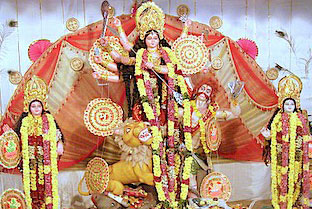|
In the 'Ramayana', Lord 'Rama' along with his brother
and army of monkeys lead by Hanuman went to 'Lanka' to
rescue his wife, Sita, who was abducted and imprisoned
by the ten headed 'Ravana', the king of the Demons in
Lanka.
Before his final battle with 'Ravana', Lord 'Rama'
seeked the blessings of Devi 'Durga' for defeating 'Ravana'.

He was given to understand that the Goddess would be
pleased only if she was worshipped with one hundred Blue
Lotuses. After travelling and searching the whole world,
Lord 'Rama' gathered only ninety-nine Blue Lotuses. So
he finally decided to offer one of his eyes, which
resembled Blue Lotuses. Durga, being pleased with the
devotion of 'Rama', appeared and blessed him for the
battle.
The fierce and decisive battle started on the day of 'Saptami'
and Ravana was finally defeated and killed on the 'Sandhikshan'
i.e. the crossover period between Ashtami,the next day
and Navami , the day after. 'Ravana' was cremated on
Dashami.
The main ritual of Durga Puja spans a period of four
days. However, in case of traditional and household
pujas, the festivities last till ten days. Debi-Pakkha
is the name given to the fortnight from the new moon
till the next full moon. This is the most propitious
time for performing holy rites. The ritual of drawing
the eyes on the image of the goddess is called
chakkhu-daan. Symbolising the process of infusing the
image with the power of vision, this is done on Mahalaya,
the day of the new moon.
The main puja starts from Shasthi, which is the sixth
day after the new moon. On Saptami, the image of the
goddess is infused with life through a process called
Bodhon. Early in the morning, the pran of the Devi is
put inside the image after it is brought from a nearby
river through the medium of a banana plant, called the
Kola Bou. The Kola Bou, bathed and draped in a new
yellow saree, resembles a newly wed bride. Ashtami is
universally accepted as the culminating point of the
four day celebrations. It was on this day that Durga had
killed Mahishasura. The ritual of Sandhipuja marks
Sandhikkhan, the juncture between Ashtami and Nabami.
The main attraction of Nabami is the Maha-Arati held in
the evening. On Dashami, the image is immersed in a
river, and people bid a sorrowful farewell to the Mother
Goddess, and the wait begins for yet another year.
Bijoya is a special ritual whereby peace and good
relations are reaffirmed. Families exchange sweets and
people embrace each other, vowing brotherhood. Bijoya
continues till the next new moon, when Kali Puja is
held.
|